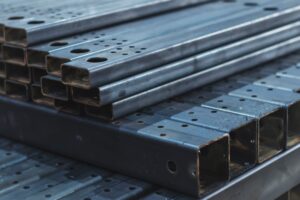Intro
A lot of people choose to laser cut their aluminum pieces so they can get reliable results, fast turnarounds, and inexpensive parts. However, laser cutting isn’t as easy as just hitting a button on your laser cutting machine — there are limitations and best practices that you need to understand first.
In this quick guide, you’ll learn how to laser cut aluminum. Our experts will cover how this technology works, some benefits of laser cutting your aluminum, and considerations to remember before you get started.
What Is Laser Cutting?
Laser cutting is a type of fabrication process that uses high-strength lasers to physically cut through material on a metal bed. Modern laser cutters are CNC machines, so the machinist needs to set up the laser cutting specifications for each project, hit the “go” button, then watch the machine run.
You can laser cut anything from leather and plastic up to high-strength metals like aluminum. The laser beam traces the cut line, and you’re left with a finished piece of aluminum that’s cut from the stock sheet.
Advantages of Laser Cutting Aluminum
Laser cutting is one of the more common ways to fabricate thin aluminum parts, but why? Here are some of the biggest advantages:
The Process is Non-Contact
With traditional machining, you can run into some issues associated with the bits coming into contact with the part. Since laser cutting is non-contact, you don’t have to worry about that. The surface of the aluminum will be consistent throughout.
You Can Choose Your Own Thickness
Laser cutters are typically able to handle a wide range of material thicknesses. For aluminum, you can easily work with pieces over 1/2” thick, with the right machine and configuration.

On the same laser cutting machine, you can also handle a much thinner gauge of aluminum, meaning that one machine can handle it all.
Laser Cutting Is Highly Repeatable
Laser cutting programs are highly repeatable. You can run the same program 100 times, and all of the parts will be virtually identical. This is great for companies that need to make any number of identical parts.
Laser Cutting Is Really Fast
Once you watch a laser cutter run, you’ll realize what we mean when we say how fast these machines are. They can easily create a full part 10 times faster than a CNC milling machine can. Laser cutters can handle internal features, external shapes, and very complex geometries.
The material thickness will determine how fast the machine can run, but thinner parts can be completed in mere minutes.
Things to Remember When Laser Cutting Aluminum
Laser cutting aluminum comes with some considerations, though. Keep these in mind so you can get the best results in all of your laser cutting endeavors.
Be Mindful of the Thickness You Select
The thickness of your aluminum can dramatically change the final part that you make. Thicker parts require the laser to run with more power, slower speeds, and typically comes with a more limited design. Thinner material isn’t as strong, but it’s less affordable and much easier to cut with a laser cutter.
An issue with especially thick pieces of aluminum is that you might notice a slight angle on the sides of the finished part. The laser’s power diminishes as it goes through the metal, so you’re left with non-square and non-flat sides.
Know the Limitations of Your Laser Cutter
Laser cutters come with specific thicknesses of material that they can reliably handle. If your machine can’t realistically work with 1/4” thick aluminum, then don’t try loading 1/4” thick aluminum on the machine. You’ll be left with a part that isn’t fully cut through, and you’ll notice a lot of issues with the final part.
Before designing your part for laser cutting, understand the limitations of your laser cutter. This also applies to the smallest radius that the machine can hold, and what type of tolerances you can expect.
Be Smart About Material Positioning and the Order of Operation
With a little experience, you’ll learn the ins and outs of material positioning and the order of operations that you should use. For now, the simple rule of thumb is that you should always try to clamp or fasten your stock aluminum to the bed of your laser cutter. This ensures the material doesn’t move out of position during the cutting operation, leaving you with cleaner lines and more predictability.
As far as the order of operations, always cut internal features and geometries before cutting the external shape of the part.
Conclusion
Knowing about laser cutting aluminum is a great way to get the best results in every cutting operation. It’s a great fabrication process that can save you time, money, and allow for more intricate designs. At Rapid Axis, we offer full-scale laser cutting operations. We can handle your aluminum projects, no matter how large or small they are. Get a free quote today.

